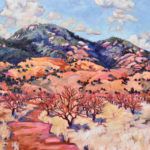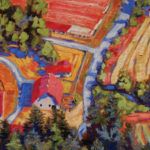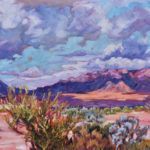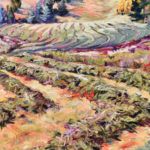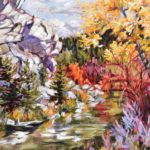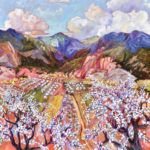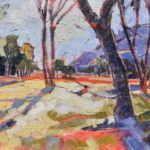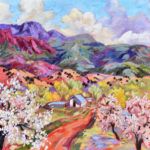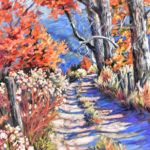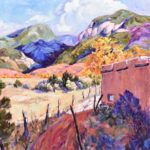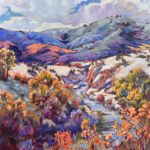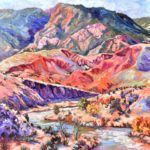Margaretta Caesar relies on bold color to capture the thrilling beauty of the landscape
By Bonnie Gangelhoff
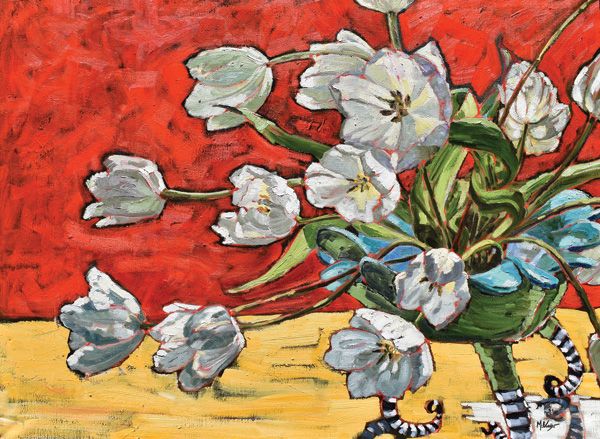
Margaretta Caesar, Always Glad to See You, oil, 40 x 60.
This story was featured in the July 2020 issue of Southwest Art magazine. Get the Southwest Art July 2020 print issue or digital download now–then subscribe to Southwest Art and never miss another story.
EARLY IN HER art career, Margaretta Caesar vowed that someday she would paint like the Dutch masters, creating classic scenes with rich, dark green and black backgrounds. Caesar recalls toiling away on her first attempt at this style and then proudly asking her oldest daughter for an informal critique. Her daughter, she recalls, took one look at the Dutch masterpiece and declared it “boring.” Caesar remembers saying to herself, “‘Aha, I’ll show her.’ So I did a crazy aspen grove in wild colors—lots of pinks, oranges, and purples. By the time I finished the work, I had discovered my love of color, and I let loose.”
Today Caesar is known for the bold, vibrant palette in her paintings, which are mostly landscapes but also include the occasional still life and figure. The Colorado artist is not shy about playing fast and loose with Mother Nature’s color palette. In fact, in terms of color, she is fond of saying, “Everything in my world is slightly enhanced. Trees can be red and cows blue. I never feel constricted by reality when I paint. It’s through enhanced, sometimes surprising color that my landscapes come alive.”
Caesar’s scenes also come alive through the artist’s use of energetic brush strokes. She uses a generous amount of paint and large brushes, allowing the lines created by the bristles to remain visible as part of the painting. Thus her spirited approach to both color choice and paint application combine to create a sense of spontaneity in her works. “I am always struggling to balance that fresh, loose, heavy impasto with the sophistication of brushwork, composition, and knowledge that I’ve acquired through the years,” she says. “I want viewers to see the direction of the brush strokes and the depth of the paint.”
- Margaretta Caesar, An Apple a Day, oil, 36 x 48.
- Margaretta Caesar, Down on the Farm, oil, 24 x 30.
- Margaretta Caesar, Drama in the Desert, oil, 24 x 36.
Inspiration for Caesar’s landscapes often springs from the unspoiled natural wonders of the Southwest, mainly the varied terrains of Colorado and New Mexico. Another major influence on her work is painter André Derain [1880-1954] and the Fauvist art movement. The Fauves—French for “wild beasts”—were an early 20th-century cadre of artists who emphasized the use of strong color without restricting their art to photorealistic interpretations of subject matter. Simplification, abstraction, wild brushwork, and saturated color were the hallmarks of the movement.
Around the same time the Fauves were painting in France, artists such as E. Martin Hennings and Joseph H. Sharp were settling in Taos, NM, and portraying the desert, mountains, mesas, and peoples of the American Southwest. Caesar also cites these members of the Taos Society of Artists as influences and inspirations for her works. “Maybe it’s odd, but I feel my voice is somewhere in between the two, the Fauves and the Taos painters,” she says. “I guess I could be called a realistic expressionist. Though I’m not fond of labels.”
SPRING SINGS IN OJO is a quintessential example of Caesar’s work. In it she captures the bounty of springtime in the picturesque community of Ojo Caliente in northern New Mexico. The painting brings together the Fauves’ joyful approach to color and the southwestern subject matter reminiscent of the Taos painters. Crab apple blossoms cascade across the foreground of the painting, feeding into the foothills in the distance, and invite the viewer’s eye into the scene. Staccato dots of paint suggest the flowers; Caesar says she wanted texture, pattern, and lightness in the foreground to contrast with the more richly colored mountains in the background.
- Margaretta Caesar, Harvest Patterns, oil, 40 x 30.
- Margaretta Caesar, Shimmer, oil, 24 x 24.
- Margaretta Caesar, Spring Sings in Ojo, oil, 40 x 40.
ALTHOUGH CAESAR has lived in the foothills of Colorado’s Rocky Mountains for more than 40 years, she grew up amid the rolling hills and farms of western Pennsylvania. Her mother was an artist who painted portraits in oils and pastels as well as murals depicting native plants and wildlife on the family’s dining-room walls. “There were subtle but stunning trees, ponds, ducks, and birds,” Caesar says.
Art supplies were always available, and Caesar fondly remembers that her mother invited her to join in the fun and paint the walls, too. “Such a gift of confidence she gave us, and she didn’t even mind if our paintings morphed into her murals,” Caesar says. “She always asked us for critiques of her work, which was such an amazing way to teach someone to see.”
From an early age, Caesar knew she would be involved in the art world in the future. It was no surprise to family and friends that, when it came time for college, she majored in arts education at the University of Denver. “I wanted to be an art teacher in part for my love of kids and in part for the love of art—it was a natural fit,” she says.
After graduation Caesar landed a position as an art teacher at a small elementary school not far from her home. When that job ended, she began a long stint of substitute teaching, mainly in math and science, at a nearby public high school. Following in her mother’s footsteps, she also painted murals for residences and businesses in the Denver area. These experiences—along with raising three children—were rewarding and joyful, but they left no time to create artwork of her own. But in 2009, after more than 25 years in education, she decided the time had come for a change. She quit the teaching life to renew her interest in the artist’s way. “I got a bee in my bonnet that I wanted to paint oil on canvas,” she says. She was reluctant to take classes or workshops at that point because she didn’t yet know who she was as an artist. She worried that she would try to paint like the teacher without finding her own voice. Instead, she decided, she would be her own teacher.
- Margaretta Caesar, Zapata Shadows, oil, 16 x 20.
- Margaretta Caesar, Down the Road, oil, 24 x 24.
- Margaretta Caesar, Follow Me, oil, 30 x 30.
Early on she recruited her husband, Brewster, to take photographs as reference material for her. For a while she worked alone in her studio, but soon she started displaying her work to the public at regional art fairs, including the Art Students League of Denver’s Summer Art Market. In 2011, at an art show in Beaver Creek, CO, a collector suggested that Caesar contact Paula Conley, who owned the Arts at Denver gallery. Conley agreed to represent Caesar on a trial basis; the deal soon became permanent when three of the artist’s works sold in a two-week period. Arts at Denver closed its doors in 2019, but for about seven years, Caesar remained the top-selling artist at the gallery.
STEP INSIDE Caesar’s studio in Morrison, CO, and you’re likely to hear music blasting—everything from Verdi’s Aida to Springsteen’s Born in the USA. “I paint and dance and take breaks to check out the bird life along the creek outside,” Caesar says. In fact, that creek is captured in her painting titled SHIMMER. Some of her landscapes, like this one, tend to be realistic renderings of a scene, while others are a composite of elements like mountains, trees, creeks, and meadows from across the West. “The bridge in SHIMMER really is red,” Caesar says, adding that, in this particular instance, she didn’t enhance or change the color.
Whether a scene is a realistic rendering or a composite, the artist almost always begins with an underpainting in shades of red and a blend of what she calls the “yucky” oils left over on her paint table. Caesar uses a rag to “smoosh” this paint around the canvas, not in any controlled way but rather creating spirited swirls of color. “It’s critical that the underpaintings shine through the subsequent layers to add depth and light. I think most of my work might fit into a ‘red phase,’” she says. “It’s just such an eye-catching, warm, happy color field.”
- Margaretta Caesar, Hymns From the Hills, oil, 36 x 48.
- Margaretta Caesar, In the Shallows, oil, 36 x 36.
- Margaretta Caesar, The Charm of the Chama, oil, 36 x 36.
Caesar says that her mantra these days comes down to this: “Be bold. Use reds, coral, salmon, cherry, and use them all together.” The artist says this approach to color stems from two sources: her mother and artist Lynn Rowan Myers. She never met Myers, who passed away in 2008, but Caesar studied and admired her paintings from afar. Myers, a well-regarded landscape painter who was also represented by Arts at Denver for many years, was known as a talented colorist.
Wanting to change things up a bit, Caesar has lately been exploring some blue hues, with a possible “blue phase” in the offing. And what better subject matter for these new color explorations than winter snowscapes and mountains blanketed with bluebell wildflowers in the spring—a perfect fit, she says.
If she does move into a “blue phase,” viewers should know that there is no hidden message or agenda to puzzle over like there was in Picasso’s melancholy Blue Period. “My art is not meant to be thought-provoking. It is meant to be heartfelt,” Caesar says. “I want it to remind viewers of someplace they have been or may want to go. I just want people to be thrilled by the beauty of a place.”
representation
Saks Galleries, Denver, CO; K. Newby Gallery, Tubac, AZ; Mountain Home, Evergreen, CO.
This story was featured in the July 2020 issue of Southwest Art magazine. Get the Southwest Art July 2020 print issue or digital download now–then subscribe to Southwest Art and never miss another story.
MORE RESOURCES FOR ART COLLECTORS & ENTHUSIASTS
• Subscribe to Southwest Art magazine
• Learn how to paint & how to draw with downloads, videos & more
• Sign up for your Southwest Art email newsletter & download a FREE ebook






